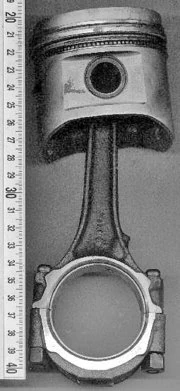
piston + connecting rod
In general, a piston is a sliding plug that fits closely inside the bore of a cylinder.
Its purpose is either to change the volume enclosed by the cylinder, or to exert a force on a fluid inside the cylinder.
Internal combustion engine[]
Most pistons fitted in a cylinder have piston rings. Usually there are two spring-compression rings that act as a seal between the piston and the cylinder wall, and one or more oil control rings below the compression rings. The head of the piston can be flat, bulged, or otherwise shaped. Pistons can be forged or cast. A special type of cast piston is the hypereutectic piston. The piston is an important component of a piston engine and of hydraulic pneumatic systems.
In an Otto or Diesel engine, the head of the piston forms one wall of an expansion chamber inside the cylinder. The opposite wall, called the cylinder head, contains inlet and exhaust valves for gases.
As the piston moves inside the cylinder, it transforms the energy from the expansion of a burning gas (usually a mixture of petrol or diesel and air) into mechanical power (in the form of a reciprocating linear motion). From there the power is conveyed through a connecting rod to a crankshaft, which transforms it into a rotary motion, which usually drives a gearbox through a clutch.
Ways of making power[]
There are two ways that a piston engine can make power. These are the two-stroke cycle and the four-stroke cycle. A two-stroke engine produces power every stroke, and causes more pollution than a four-stroke engine, which produces power every other stroke. In theory, a four-stroke engine has to be larger than a two-stroke engine to produce an equivalent amount of power. Two-stroke engines are becoming less common these days, mainly due to air pollution. Two-stroke engines usually need more maintenance and tend to wear out faster than four-stroke engines.
External combustion engine[]
A steam engine is another type of piston engine. In most steam engines, the pistons are double acting: steam is alternately admitted to either end of the cylinder, so that every piston stroke produces power. .
External links[]
- Flywheels - index at PESWiki.com
| This page uses Creative Commons Licensed content from Wikipedia (view authors). | 
|